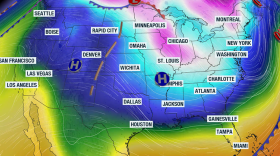-
A cold front brings welcomed showers and storms to the Panhandle and parts of the Peninsula, but it fizzles as it crosses the state. Brief changes will be felt.
-
More than 122 million Americans are expected to travel during the busy holiday period, with generally quiet weather across much of the country but stormy conditions along the West Coast.
-
A strong cold front will bring much colder air to Florida late this weekend and early next week, with lows dropping into the 20s and 30s across northern Florida.
-
The Florida Department of Transportation says it has boosted its winter-weather preparedness following lessons learned from January historic winter storm.
-
A low-pressure system will get stuck in the Southeast, keeping some fronts at bay right over northern Florida—significant contrasts in temperatures and humidity between the southern and northern halves of the State.
-
According to NOAA's latest December outlook, Florida is expected to warmer than average temperatures and below average rainfall during the month.
-
Florida's fog season typically runs from late fall through the early spring due to the combination of moisture around and cooler air temperatures.
-
The Thanksgiving holiday travel period is underway with AAA estimating nearly 82 million Americans will travel via either land or air to their destinations.
-
A significant disruption of atmospheric patterns around the Arctic is expected to begin over the next few weeks, which could allow for cold air to spill into the country.
-
Temperatures will be about 20 degrees below average for this time of year, and the wind will make it feel even colder! How long will it last?
-
La Niña conditions are expected to start influencing Florida’s weather. Historically, La Niña Novembers have featured below-average rainfall and only brief cold snaps.
-
Showers and thunderstorms during the first half of the workweek could put down around an inch of precipitation, with heavier accumulations expected in the Florida Panhandle.
Play Live Radio
Next Up:
0:00
0:00
Available On Air Stations












